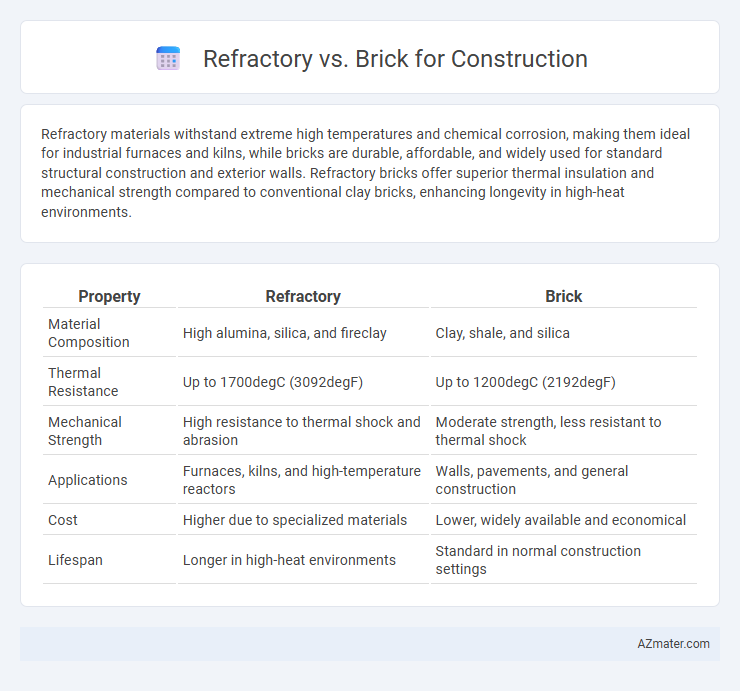Refractory materials withstand extreme high temperatures and chemical corrosion, making them ideal for industrial furnaces and kilns, while bricks are durable, affordable, and widely used for standard structural construction and exterior walls. Refractory bricks offer superior thermal insulation and mechanical strength compared to conventional clay bricks, enhancing longevity in high-heat environments.
Table of Comparison
| Property | Refractory | Brick |
|---|---|---|
| Material Composition | High alumina, silica, and fireclay | Clay, shale, and silica |
| Thermal Resistance | Up to 1700degC (3092degF) | Up to 1200degC (2192degF) |
| Mechanical Strength | High resistance to thermal shock and abrasion | Moderate strength, less resistant to thermal shock |
| Applications | Furnaces, kilns, and high-temperature reactors | Walls, pavements, and general construction |
| Cost | Higher due to specialized materials | Lower, widely available and economical |
| Lifespan | Longer in high-heat environments | Standard in normal construction settings |
Introduction to Refractory and Brick Materials
Refractory materials are specialized heat-resistant substances capable of withstanding extreme temperatures, making them essential for industrial furnaces, kilns, and fireplaces. Brick materials, commonly composed of clay or concrete, offer versatility in structural construction but typically lack the high-temperature resilience found in refractories. Understanding the thermal properties and material composition is crucial for selecting between refractory and brick applications in construction projects requiring durability and heat resistance.
Key Differences Between Refractory and Traditional Brick
Refractory bricks, also known as firebricks, are specially designed to withstand extremely high temperatures and thermal stress, making them ideal for use in furnaces, kilns, and fireplaces, whereas traditional bricks are primarily used for general construction due to their moderate heat resistance and structural properties. The composition of refractory bricks includes fireclay, silica, alumina, and other minerals that enhance heat resistance, whereas traditional bricks are typically made from clay or shale and are fired at lower temperatures. Unlike traditional bricks, refractory bricks possess low thermal conductivity and high melting points, ensuring durability and thermal insulation in high-temperature industrial environments.
Composition and Manufacturing Processes
Refractory materials are composed of highly heat-resistant compounds such as alumina, silica, and magnesia, specifically engineered to withstand extreme temperatures and chemical corrosion, while bricks are primarily made from clay, sand, and water, undergoing a simpler firing process. The manufacturing process of refractory bricks involves precise mixing of raw materials, shaping, firing at ultra-high temperatures, and sometimes adding binders or additives to enhance thermal properties. In contrast, traditional brick production entails molding clay mixtures and firing them at lower temperatures, resulting in materials suited for structural rather than high-temperature industrial applications.
Heat Resistance and Thermal Performance
Refractory materials and bricks differ significantly in heat resistance and thermal performance, with refractories designed to withstand extreme temperatures often exceeding 1500degC, making them ideal for furnaces and kilns. Conventional bricks generally have lower heat resistance, typically around 1000degC, and their thermal conductivity varies widely, affecting insulation efficiency. The specific heat capacity and thermal expansion rates of refractory ceramics enhance durability under thermal stress, whereas standard bricks are suited for moderate heat applications in residential and commercial construction.
Applications in Modern Construction
Refractory materials are essential in high-temperature applications such as furnaces, kilns, and reactors, providing thermal insulation and resistance to chemical erosion, making them ideal for industrial sectors like steelmaking and cement production. Bricks, particularly clay and concrete variants, serve primarily in structural and aesthetic roles for walls, facades, and pavements, valued for their durability, thermal mass, and fire resistance in residential, commercial, and infrastructural projects. Modern construction integrates refractories for specialized thermal management while employing bricks for load-bearing and architectural purposes, optimizing both performance and cost-effectiveness.
Cost Comparison: Refractory vs Brick
Refractory materials typically have higher upfront costs compared to traditional bricks due to their specialized composition and ability to withstand extreme temperatures in industrial applications. While bricks are more affordable and widely available for standard construction, refractories offer longer durability and lower maintenance expenses in high-heat environments, potentially reducing long-term costs. Cost efficiency depends on project requirements, where brick is favored for budget-sensitive builds and refractory is chosen for performance-critical constructions.
Mechanical Strength and Durability
Refractory materials exhibit superior mechanical strength and thermal resistance compared to standard bricks, making them ideal for high-temperature industrial applications. Their enhanced durability ensures prolonged performance under extreme thermal cycling, reducing maintenance and replacement costs. Standard bricks, while cost-effective, lack the mechanical resilience and heat tolerance required for demanding construction environments.
Installation and Maintenance Considerations
Refractory materials require precise installation techniques, including correct curing and firing processes to ensure thermal stability and durability, whereas traditional bricks demand less specialized handling but may lack high-temperature resistance. Maintenance for refractory installations involves routine inspections for cracks and spalling to prevent structural failure, while brick structures typically need simpler repairs like repointing mortar joints. Understanding these differences is critical for selecting appropriate materials based on the thermal and mechanical demands of the construction project.
Environmental Impact and Sustainability
Refractory materials, designed to withstand extreme heat, often contain industrial compounds that may pose environmental disposal challenges compared to traditional brick, which is primarily composed of natural clay and fired at lower temperatures. Bricks, especially those made from locally sourced clay, tend to have a smaller carbon footprint and greater sustainability due to their natural composition and lower energy consumption during production. Sustainable construction increasingly favors bricks for their recyclability and minimal ecological impact, whereas the specialized nature of refractory materials necessitates careful management to mitigate environmental harm.
Choosing the Right Material for Your Project
Choosing the right material for your construction project depends on the specific thermal, mechanical, and chemical requirements of the environment. Refractory materials offer superior resistance to extreme heat and chemical corrosion, making them ideal for high-temperature applications such as furnaces and kilns. Bricks, while durable and cost-effective for general construction, lack the specialized heat resistance of refractories and are better suited for structural walls and exterior facades.

Infographic: Refractory vs Brick for Construction
 azmater.com
azmater.com